
One of the oldest natural fabrics, linen was first made from the flax plant thousands of years ago. This lustrous, high-quality fabric continues to be popular today. Durable, strong, smooth, and highly breathable, linen is ideal for use in clothing.


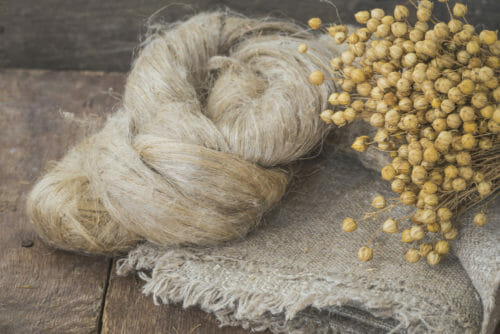

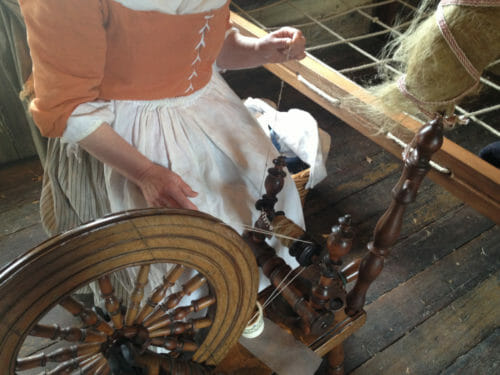

If cared for properly, linen products can last for longer than many other fine fabrics. However, many people shy away from linen because of the fabric's reputation for being difficult to handle. Luckily, remembering a few basic rules is all that is necessary for proper linen care.
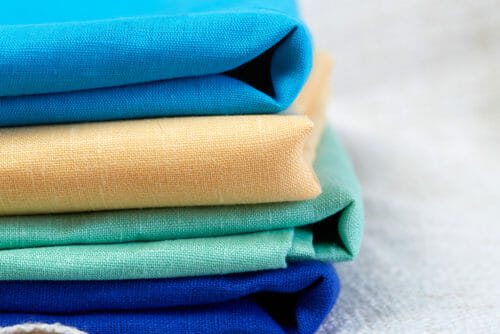

A linen owner should follow whatever specific instructions the manufacturer has placed on the label. Linen should be either machine- or hand-washed (but not dry cleaned unless specifically mentioned on the fabric care label) in cool or lukewarm water. Hot water should never be used since higher temperatures will wear out the fibers more quickly.
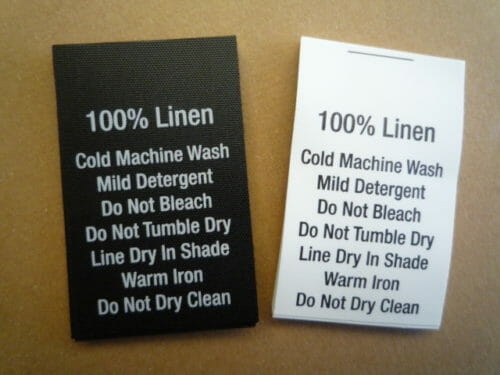

Since harsh treatment can easily damage linen, the gentlest wash cycle available should always be selected. For similar reasons, a gentle, non-astringent soap should be employed. Even if the fabric is stained, bleach should not be used since bleach weakens linen fibers and can degrade the colors of dyed linen.
To prevent linen items from getting tangled and stretched or pulled, washing machines should be only partially filled, leaving enough room for the fabrics to move freely.
Colored linen and white linen must never be washed together, and linen should not be cleaned with other fabrics.
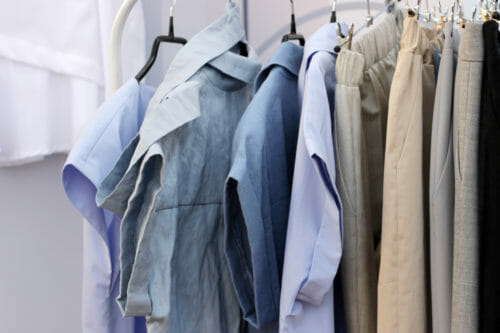

If hand washing is employed, it is again critical to not be too rough with linen products. Only gentle motions will leave linen in good condition. Pulling, wringing, twisting, and scrubbing will harm the linen fibers.
After washing is finished, it is important not to dry linen out too much in a drier. If linen dries out completely, it can become stiff and brittle. Instead, linen should be left slightly damp, and allowed to finish drying on its own.
Placing linen on a hanger will soon complete the process; letting the item dry on a flat surface might be preferable, as it lowers the chance a crease will form in the fabric. Though ironing linen is usually not necessary, the best time to do so is when the linen is still a little wet.
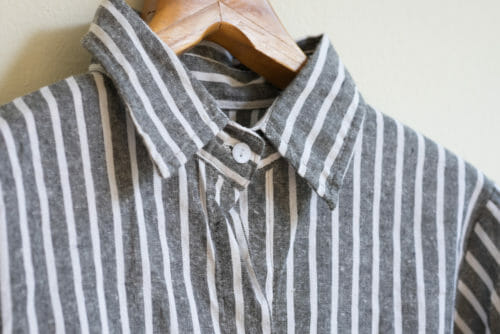

After the washing and drying process is completed, linen should be stored in a dry, cool area until it is next needed. It is best to not fold linen garments when they are put away since linen with folds, creases, or other marks is likely to wrinkle or deform and lose its shape.
Linen has a reputation for being as high maintenance as it is high quality. However, although linen is not as easy to care for as with other fabrics, following a few basic rules is all that is needed to preserve linen for many years.
I hope these few tips about linen fabric care help you and even convince you to make something from this wonderful and natural fiber fabric. If you have other thoughts on how to best care for linen, please leave them in the comments below. The other readers will really appreciate it.








2 part. I want to soften the color. It is a bit brassy. Suggestions on how to tone it down? It is a golden brown. Also I have a flat sheet that is too big. Wondering if I should shrink it or have it cut down and sewn. Any wisdom would be helpful
I love linen! Something you didn’t mention is that it gets softer the longer you have it. I’ve been told that one reason folks don’t like it is that it wrinkles too much. I put mine in the dryer until damp. Hang to finish drying. The older it gets the better. As I said, gets softer and stops wrinkling with age.
In 60 years of sewing, I’ve must everything from underwear to wedding gowns but I have never used linen, and I really don’t know why.
Now I need a nice simple, “go-anywhere” summer dress and linen would be perfect, so better late than never!
I’d like to line it but want it to stay cool and “breathable”. So what would you suggest for the lining?
Thanks for any advice you choose to give.
I have a dark indigo line that I plan to use for some pants. The colour, unfortunately, bleeds and despite soaking and washing I can’t seem to remove all the excess dye. Given that linen can’t take as much abuse as, say denim, how would you recommend I tackle the dye bleed issue. Ignoring the issue and waiting for it to work itself out doesn’t seem like an option for me as I really can’t handle dealing with the bleeding for months. I’d prefer to have it resolved before I even go to sew the fabric to avoid turning everything blue. Thanks!
Have you tried washing it with vinegar or salt? They usually set dyes in cotton. It might stop the bleeding issue.
Thanks for this information. I have had several linen shirts over the years. Have done the unthinkable to one-bleach and the dryer. but luckily still wearable. The other white one will not receive the same harsh treatment as to the other as I want it to last for a long time.
I have started sewing with linen for some slacks ands jackets so your post is most timely.
Thank you
On my iron, the hottest setting is for linen (hotter than cotton). So I’m surprised to read here that it should have only a warm iron. Which is correct?
If you only iron linen with a warm iron, you’ll never get wrinkles out. I’ve sewn and worn linen for more than fifty years and I do not treat it delicately. It wears like iron.
I serge the cut ends of my linens together, then wash and dry in the machines, to get any shrinkage out of the way, before making the garment. Then I wash and dry the garment the same way. I have never had trouble with linens, and love love love it!
Thank you for the information … i have some linen that I have been too afraid of turning into a garment … now I will tackle it soon with an educated approach!
I get my linen fabric online from fabrics-store.com. Gorgeous fabric in many colors and weights. I serge the edge before washing then dry in machine. I suggest taking it out while still slightly damp and then iron immediately. I found drying too much left wrinkles that I couldn’t iron out. Linen is supposed to be casual and “wrinkled” and gets softer and softer with wearing.
The care instructions seem incredibly labour intensive for a fabric that is supposed to improve with wear. Also, I am surprised you feel linen needs little or no ironing- it is very prone to crumple and crease before during and after every stage of putting on, wearing, washing and drying. and ironing, if you’re not careful!
It all depends how you wash it if done by hand and no twisting, also it depends on the pattern and look you wan to achieve. For a relax by the beach dress taking it with you on vacation often a sock the dress in water and hang on a hanger in the bathroom next day I don’t iron. Must admit though it works best with a print.
I have a casual linen shirt, I’ll give your method a try and see how it goes. Thanks for the tip!
Whenever I had had linen, it has always shrunk. I love the feel, especially in the summer. I follow the instructions carefully but no matter whether it is pre-made or I buy the fabric and make, it will always draw up. How do I prevent this?
When Buying linen I wash it and dry it in the dryer until is very dry then I iron it using a lot of steam. That way I make sure the shrinkage will not take place when I finish the garment. Linen is a wonderful fabric that will absorb sweat, as it does the fibers will expand giving the garment a looser look. This is why linen is not ideal for form fitting dresses or pants, it is better suited for loose and flowy styles.
I use linen more than any other fabric. I love it. When I first get my fabric I wash it at 60c and tumble dry on high. I then hang it and steam it until it’s damp then iron it. Once that’s done I hang it again and leave it for 48 hrs. It will ‘give’. Only then do I make clothes and furnishings with it. My clients (and I) haven’t mentioned it shrinking on them. I give care instructions to wash at 40c with wool/silk washing liquid and to hang or low heat tumble dry until damp, iron damp and hang to finish drying. It’s labour intensive but I have developed this technique over many years and touch wood it’s not let me down.
I just bought a length of 100% navy blue linen. I am not sure how to prep this fabric before cutting my garment. I have read several places to dry clean linen if you want to keep it crisp, as in suit jackets. But I want linen for a softer, more relaxed feel, so I will want to wash it, and your information is helpful. But what can I expect in prepping it? Will it shrink much? Do dark color dyes run? What about ironing? The linen setting is the highest setting on your iron, so it must be able to handle heat.
Hi Patricia, al depends of the quality of linen and what dying process the company has used. Wash the linen as you are planing to wash the garment. i tend to place it i the washing machine and dry completely. I am left with a crumpled fabric and spend several minutes ironing in the highest setting with a lot of steam. I find I have lost 4 to 6 inches in length. Not a problem because now I can choose a pattern that is suitable for the fabric. Loose and flowy is best.
I’ve recently feel in love with the look and feel of linen. I have never sewn with it but I have some yardage that needs a nice simple short sleeve dress. Any ideas? I’m 5’5″ and short torso length, with that lovely rounded and rolled middle.
I have made several dresses using the Vivienne Dress pattern from Style Arc it is graceful,comfortable and stylish. I think your figure and mine sound very similar. I have made two from cotton, one from Rayon and have one in progress in linen.
Unfortunately it does not have sleeves, hope this is helpful. I usually pair this dress with a light swing jacket called a little something. Mostly the jacket is to cover my old lady arms,
Laura
I absolutely love the look of linen. I didn’t know it should be removed from the drier while still damp. Will this help to eliminate some of the wrinkles?
Thanks Ladies! I love the look and feel of linen, but I did not know to never have it dry cleaned! 100% linen is impossible to find in my area (we DO NOT have luxury fabric stores any more). I am inspired to go looking for linen now!
My husband take flax – just to sprinkle on food, we use linseed oil which is flax seed to wash and polish our BBQ steel griddle (by Blackstone). Just had to share the FLAX! Thanks for your explanation & photos… Lynda Turmenne, Beverly Hills, FL.
what is the best way to repair a small tear? Is it necessary to use linen thread?
No Not all, the most important t is to match the color of the fabric. The technique will depend on how large is the tear.
I very much appreciate this information, There is a lot about washing linen that I did not know before. I wish this article was in printable form so that I could save it forever.
I have a question. I bought some white linen to make a pair of pants but it is kind of see-through. What can I line or better yet underline them with? They will be hand washed in the end. Of course I will preshrink it first. Thank you.
Hi Lynne, I would line them with a very soft Japanese 100%Cotton or Satin Silk.
I’ve heard that the “trick” to ensuring a linen garment does not become a wrinkled mess while wearing it is to line it with silk organza.
I love linen in all seasons here in Panama. With the high humidity any wrinkles fall out as soon as they are made. It’s never crisp but I don’t wear crisp. Thanks for the care tips – I understand now why my favorite walking shorts wore out after only four years.
Hi Kim, the humidity in my country of birth can be stifling at times and linen is the only way to go. Happy to know you know how to make the best of the weather. Kind Regards,
I love linen clothes but not the wrinkled look. Should fabric softener or dryer sheets be used?
I used to weave linen (industrially). I hated it then because it was so rough but I just love it for clothes when I travel. It’s cool. Literally?
I agree with Sunny above I have washed household linen at high temps and its always been fine – however on habit I generally wash them on lower temps now 40deg. I have never used and dont own a dryer so will dry naturally. My only comment on linen is that dye does not reach the inner fibre so its prone to fading with time and worth re-dying. I adore linen clothes as they become the wearers as linen will slow adopt the form of the wearer – wonderfully easy fabric to sew also – secondhand linen trousers sell for about a euro/dollar here in charity shop as they have gone out of fashion or something, so I usually remake them into shirts
Great information! I LOVE the look of linen but have hesitated using it. I thought it always wrinkled like crazy but I think I’ll give it a try now. I can easily line dry it. Thanks for the good information!
I still have a lot of towels, draps etc in my household, some of them from my grandma, but I always wash them in the machine with very high temp (60°-95°C). I never had any damage. The old pieces are white, the newer ones are colored. And I always iron them on the highest temperature possible. I have also some few garments in linen jersey and wash them in the machine upto 60°C.
Sorry I made different experiences as you describe.
Hi Sunny, that’s great to hear of your experience with linen. Thanks for sharing.